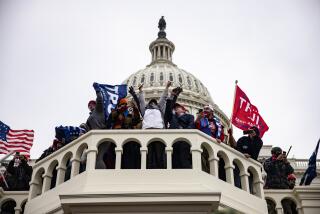Editorial: March for Our Lives was a powerful, galvanizing moment. We can’t let its momentum fade away

- Share via
It was heartening to see the outpouring of personal stories, anger and resolve during the weekend March for Our Lives anti-gun violence protests and the ensuing social media discussions, a long-running debate re-energized through the activism and resolve of kids. It was their day in the sun, and they performed admirably, as did the adults who helped give significant mass to their movement. But the nation can’t let the demonstrations vent off righteous anger over Congress’ subservience to the gun lobby and its embrace of the mythical sanctity of the 2nd Amendment. This weekend must be the beginning of something.
But how to achieve that? Another day of mass disobedience is scheduled for April 20, with more than 250,000 high schoolers already vowing via a Change.org petition to walk out of their classes, an echo of the protest that arose a month after the Valentine’s Day massacre at Florida’s Marjory Stoneman Douglas High School. More power to them — another day of action will help keep the issue current. But as the March for Our Lives activists have done, organizers of the high school walkouts should focus on results and launch voter registration drives ahead of the summer primaries and November general election. The nation has learned to its disgrace that tears of rage and grief over the slaughter of innocents are insufficient to move the cold hearts in Congress, or the cold hearts of the National Rifle Assn. leadership and its more radical members. It will take a much more potent form of political pressure to get anywhere near where we need to be on gun control.
We’ve been in a similar place before.
So what does the nation need? Universal background checks for any transfer of a firearm should be an easy law to enact, given that polls have found significant public support for the idea. Second, there is no need for civilians to own such weapons of war as semiautomatic rifles. Some might find them fun to shoot, but that’s hardly reason to loose them upon a civil society. And as for those who say these weapons are necessary for hunting, they need target practice more than they need access to a firearm that can fire bullets as fast as a shooter can make successive pulls on a trigger. If a ban on such weapons is beyond political reach, Congress should at a minimum outlaw bump stocks and other related devices that can convert semiautomatic guns to near-automatics. President Trump has proposed doing that by regulation, but it’s unclear whether his move will pass a court challenge; Congress can and should do it by law.
There are solutions to pursue at the state level too. Given the lack of action in Congress, many states — including California — have adopted much more stringent restrictions than federal law imposes. For instance, it is illegal to buy or sell an assault-style rifle in this state, and county sheriffs can deny concealed weapon permits to applicants who do not make a plausible case for why they need one. So Capitol Hill isn’t the only pressure point for gun control; statehouses across the country should be pushed as well. Many gun owners say they disagree with the absolutist positions of the NRA; this would be a good time to join with those seeking reforms to establish a common ground that could help marginalize the NRA’s lobbying and ballot-box influence, especially in states with a long history of hunting-rooted gun culture.
And we have to recognize, too, that while massacres such as the one in Parkland, Fla., grab the nation’s attention, our biggest daily gun risk comes from one-on-one encounters involving people we know. Murder-suicides occur all too easily in moments of domestic violence just because a gun is within reach. Middle-aged white males, who as a group traditionally are the largest bloc of support for 2nd Amendment rights, also are at the highest risk of killing themselves with their weapons.
Still, it is the massacres that might move the political needle. We’ve been in a similar place before — the outpouring of anger and grief that followed the Sandy Hook Elementary School massacre felt like a galvanizing moment. But it dissipated as the grief faded. We can’t let that happen again. This is a moment that must be seized and, finally, converted into meaningful change.
Follow the Opinion section on Twitter @latimesopinion or Facebook
More to Read
A cure for the common opinion
Get thought-provoking perspectives with our weekly newsletter.
You may occasionally receive promotional content from the Los Angeles Times.









